|
Memorandum Number Three:
Thesis – The Order Creates The Soviet Union
In an earlier book, published in 1974, we presented major evidence
of Wall Street assistance for the Bolshevik Revolution. This
assistance was mainly cash, guns and ammunition, and diplomatic
support in London and Washington, D.C.
Wall Street And The Bolshevik
Revolution also introduced the concept which Quigley described,
i.e., that Morgan and other financial interests financed and
influenced all parties from left to right in the political spectrum.
This Memorandum continues the story, but now links The Order to the
earlier evidence of Wall Street involvement.
On the following pages we reproduce a map of the Wall Street area
and a list of firms connected with the Bolshevik Revolution and
financing of Hitler located in this area. We can now identify the
influence, in fact the dominant influence, of The Order in these
firms.
Revolutionary activity was centered at Equitable Trust Building, 120
Broadway, in the building in the photograph on page 139. This had
been E.H. Harriman's address. The American International Corporation
was located at 120 Broadway. The Bankers' Club, where Wall Street
bankers met for lunch, was at the very top of the building.
It was
in this plush club that plans were laid by William Boyce Thompson
for Wall Street participation in the 1917 Russian Revolution.
Guaranty Securities was in 120 Broadway, while Guaranty Trust was
next door at 140 Broadway (the building can be seen to the left of
120).
I. THE ORDER PUSHES FOR ASSISTANCE TO THE SOVIET ARMY
Fortunately we
have a copy of the memorandum written by a member of The Order,
summarizing intentions for the 1917 Bolshevik Revolution. The
memorandum was written by Thomas D. Thacher (The Order'04), a
partner in the Wall Street law firm of Simpson, Thacher & Bartlett.
Thacher's address was 120 Broadway.
Today this law firm, now in
Battery Plaza, has the largest billing on Wall Street and has former
Secretary of State Cyrus Vance (Scroll & Key) as a partner. In 1917 Thacher was in Russia with William Boyce Thompson's Red Cross
Mission. After consultations in
New York, Thacher was then sent to London to confer with Lord
Northcliffe about the Bolshevik Revolution and then to Paris for
similar talks with the French Government.
The Thacher memorandum not only urges recognition of the barely
surviving Soviet Government, which in early 1918 controlled only a
very small portion of Russia, but also military assistance for the
Soviet Army and intervention to keep the Japanese out of Siberia
until the Bolsheviks could take over.
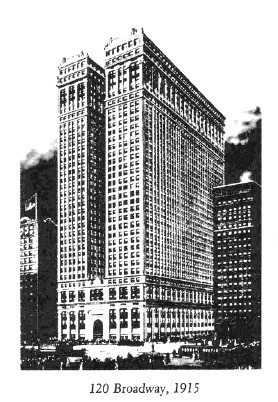 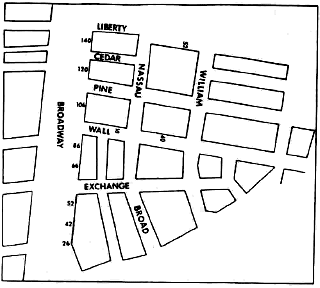
FIRMS WITH LINKS TO THE ORDER AT, OR NEAR, 120 BROADWAY IN 1917
-
120 Broadway Edward H. Harriman (before his death)
-
59 Broadway W.A.
Harriman Company
-
120 Broadway American International Corporation
-
23 Wall J.P. Morgan firm
-
120 Broadway Federal Reserve Bank of New
York
-
120 Broadway Bankers Club (top floor)
-
120 Broadway Thomas D. Thacher (of Simpson, Thacher & Bartlett)
-
14 Wall William Boyce Thompson
-
120 Broadway Guggenheim Exploration
-
15 Broad Stetson, Jennings & Russell
-
120 Broadway C.A.K. Martens of
Weinberg & Posner (the first Soviet "ambassador")
-
110 W. 40th Street
Soviet Bureau
-
60 Broadway Amos Pinchot's office
-
120 Broadway Stone &
Webster
-
120 Broadway General Electric
-
120 Broadway Sinclair Gulf
Corp.
-
120 Broadway Guaranty Securities
-
140 Broadway Guaranty Trust
Company
-
233 Broadway Anglo-Russian Chamber of Commerce
INDIVIDUAL MEMBERS OF THE ORDER AT 120 Broadway:
-
George Webster
Adams (The Order '04)
-
Allen Wallace Ames (The Order '18)
-
Philip
Lyndon Dodge (The Order '07)
Here are the main sections from the
Thacher memorandum:
"First of all ... the Allies should discourage Japanese intervention
in Siberia.
In the second place, the fullest assistance should be
given to the Soviet Government in its efforts to organize a
volunteer revolutionary army.
Thirdly, the Allied Governments should
give their moral support to the Russian people in their efforts to
work out their own political systems free from the domination of any
foreign power ...
Fourthly, until the time when open conflict shall
result between the German Government and the Soviet Government of
Russia there will be opportunity for peaceful commercial penetration
by German agencies in Russia. So long as there is no open break, it
will probably be impossible to entirely prevent such commerce.
Steps
should therefore be taken to impede, so far as possible, the
transport of grain and raw materials to Germany from Russia." 1
1 The full document is in U.S. State Department Decimal File
Microcopy 316, Roll 13, Frame 698.
The reader should note in particular paragraph two:
"In the second
place, the fullest assistance should be given to the Soviet
Government in its efforts to organize a volunteer revolutionary
army."
This assistance has been recorded in my National Suicide:
Military Aid To The Soviet Union.
It was in fact the hidden policy adopted at the highest levels, in
absolute secrecy, by the United States and to some extent by The
Group (especially Milner) in Great Britain. Thatcher apparently did
not have too much success with the French Government.
When President
Woodrow Wilson sent U.S. troops to hold the
Trans-Siberian railroad, secret instructions were given by Woodrow
Wilson in person to General William S. Graves. We have not yet
located these instructions (although we know they exist), but a
close reading of the available files shows that American
intervention had little to do with anti-Bolshevik activity, as the
Soviets, George Kennan and other writers maintain.
So grateful were the Soviets for American assistance in the
Revolution that in 1920 - when the last American troops left
Vladivostok - the Bolsheviks gave them a friendly farewell.
Reported the
New York Times (February 15, 1920 7:4):
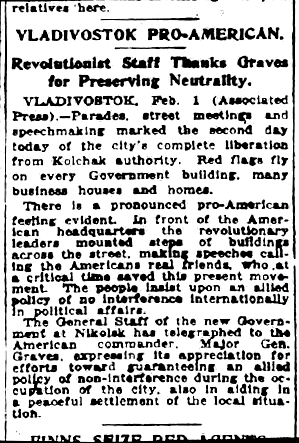
Note in particular the sentence:
"... calling the Americans real friends, who at a critical time
saves this present movement."
Normally reports inconsistent with the Establishment line are
choked, either by the wire services or by the rewrite desks at
larger newspapers (small papers unfortunately follow New York
Times). This is one report that got through intact.
In fact, the United States took over and held the Siberian Railroad
until the Soviets gained sufficient power to take it over. Both
British and French military missions in Siberia recorded the
extraordinary actions of the United States Army, but neither mission
made much headway with its own government.
So far as aiding
the Soviet Army is concerned, there are State Department records
that show guns and ammunition were shipped to the Bolsheviks.
And in 1919, while Trotsky was making anti-American speeches in
public, he was also asking Ambassador Francis for American
military inspection teams to train the new Soviet Army.
1
1
See Antony C Sutton, Notional Suicide (Arlington House, New York,
1974) and Wall Street And The Bolshevik Revolution (Arlington House,
New
York. 1974)
II. THE ORDER PUSHES FOR THE SOVIETS IN THE UNITED STATES
However, it was in Washington and London that
The Order really aided
the Soviets. The Order succeeded not only in preventing military
actions against the Bolsheviks, but to so-muddy the policy waters
that much needed vital raw materials and goods, ultimately even
loans, were able to flow from the United States to the Soviets, in
spite of a legal ban.
The following documents illustrate how members of The Order were
able to encourage Soviet ambitions in the United States. While the
Department of Justice was deporting so-called "Reds" to Russia, a
much more potent force was at work WITHIN the U.S. Government to
keep the fledgling Soviet Union intact.
Publisher's Note: To assist readers with the very poor reproductions
of the following two letters we print our reading from the copies
that we have. 211
Hon. William Kent,
May 29, 1919
U.S. Tariff Commission, Washington,
D.C.
Dear Billy:
This will introduce to you my friend, Professor Evans Clark, now
associated with the Bureau of Information of the Russian Soviet
Republic. He wants to talk with you about the recognition of
Wolchak, the raising of the blockade, etc., and get your advice in
regard to backing up the senators who would be apt to stand up and
make a brave fight. Won't you do what you can for him. As I see it,
we are taking a (unreadable) Russia that will leave our, until now,
mightily good reputation, badly damaged.
Hope to see you in
Washington soon.
Faithfully yours,
A. P.
Mr. Santeri Nourteva,
Finnish Information Bureau,
299 Broadway, City
November 22, 1918
Dear Mr. Nuorteva:
Let me thank you for your very kind letter of November 1st; I
apologize for not answering sooner.
I have read your bulletin on the barrage of lies, and I am, needless
to say, heartily sympathetic with your view of the situation and
with the work you are doing. One of the most sinister things at
present is the fact that governments are going into the advertising
business. They are organized so that they can make or wreck
movements. f am sending you, under separate cover, a copy of a
letter I have written, which I hope will interest you.
With kindest regards, I am Sincerely yours,
Amos Pinchot
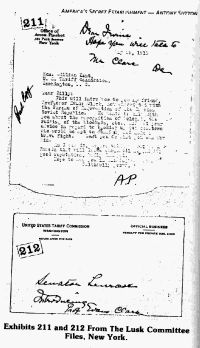 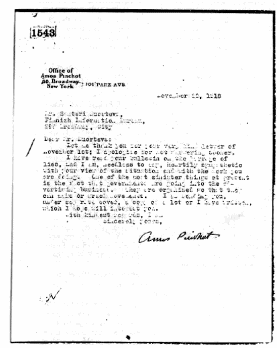
The above letter is from Amos Pinchot (The Order '97). His brother,
conservationist Gifford Pinchot (The Order '89) was also a member.
Amos Pinchot was a founder of the American Civil Liberties Union and
active in aiding the Soviets during the early days of the Bolshevik
Revolution.
The above letter, exemplifying this assistance, was sent
to Santeri Nourteva, November 22, 1918, just a year after the 1917
Revolution. Pinchot was "heartily sympathetic with your view of the
situation and the work you are doing."1
1 Exhibit Number 1543 from the Lusk Committee files, New York.
Who was Nourteva?
This name was an alias for Alexander Nyberg, a
Soviet representative in the United States. Nyberg worked for the
Soviet Bureau (at first called the Finnish Information Bureau - a
cover name), along with Ludwig C.A.K. Martens, the first Soviet
Ambassador and formerly a Vice President of Weinberg & Posner.
The
New York office of Weinberg & Posner was at - 120 Broadway! Nyberg's
assistant was Kenneth Durant, an American newspaper man, later TASS
correspondent in the U.S. and one time aide to "Colonel" Edward
House, mystery man of the Wilson Administration. Director of the
Commercial Department in this Soviet Bureau was "Comrade Evans
Clark."
Clark later became Executive Director of the influential
Twentieth Century Foundation, and at Twentieth Century Foundation we
find a member of The Order - in this case Charles Phelps Taft (The
Order '18), nephew of President and Chief Justice William Howard
Taft. In the coming volume on FOUNDATIONS, we shall see how Evans
Clark and The Order, working together at Twentieth Century
Foundation, had a significant role in the Hegelization of American
education.
The document on page 147 is a brief biography of "Comrade Evans
Clark", issued by the Soviet Bureau in 1919 on his appointment as
Assistant, Director of the Commercial Department of the Bureau, with
the task of establishing trade relations with the U.S. Note the
Harvard and Princeton associations.
Trade was vital for the survival of the Soviet Union. In 1919 all
Russian factories and transportation were at a standstill. There
were no raw materials and no skills available.
For assistance Evans Clark turned to
The Order. On May 29, 1919,
Amos Pinchot wrote fellow Skull & Bones member and strong Republican
William Kent about raising the blockade against the Soviets. William
Kent (The Order'87) was on the U.S. Tariff Commission and in turn
wrote Senator Lenroot to request an interview for "Professor" Evans
Clark.
Albert Kent, his father, was a member [The Order '53] and he
married the daughter of Thomas Thacher [The Order '35]. In brief,
two members of The Order, Pinchot and Kent, cooperated to push a
known Bolshevik operator onto an unsuspecting Senator. Neither
member of The Order advised Senator Lenroot about Clark's
affiliation with the Soviet Bureau.
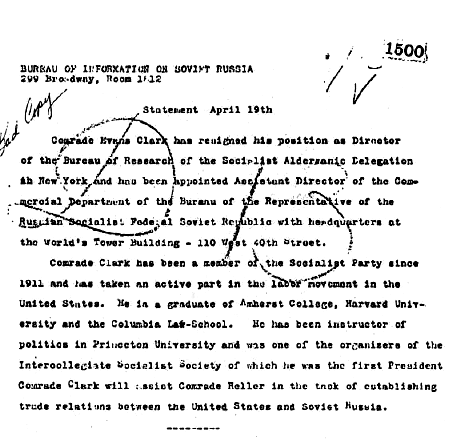
Exhibit Number 1500 From the Lusk Committee Files, New York.
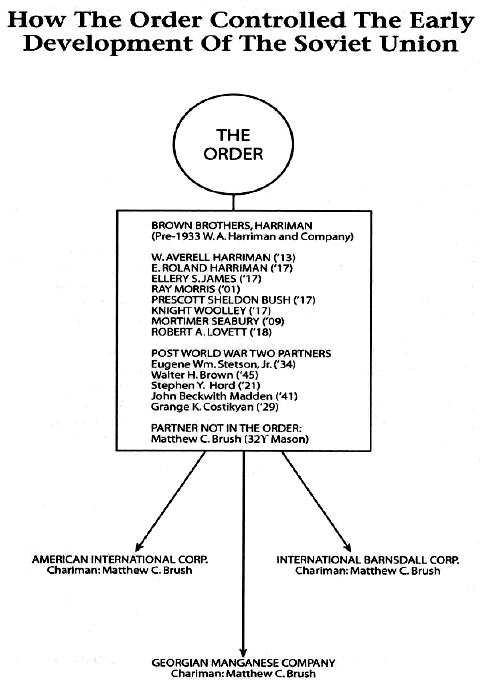
III.- HOW THE ORDER DEVELOPED THE STAGNANT SOVIET UNION
Between 1917 and 1921 the Soviets pushed their control of Russia
into Siberia and the Caucasus. As we have noted, the United States
intervened in Siberia along the Trans-Siberian Railroad. Histories
of U.S. Intervention by George Kennan and the Soviets maintain this
was an anti-Soviet intervention.
In fact, it was nothing of the
kind. The U.S. spread troops along the Siberian railroad only to
keep out the Japanese, not to keep out the Soviets. When they left
through Vladivostok, the Soviet authorities gave American forces a
resounding send-off. But this is yet another untold story, not in
the textbooks.
The immediate problem facing the Soviets was to restore silent
Russian factories. This needed raw materials, technical skills and
working capital. The key to Russian reconstruction was the oil
fields of the Caucasus. The Caucasus oil fields are a major segment
of Russian natural resource wealth.
Baku, the most important field,
was developed n the 1870s. In 1900 it was producing more crude oil
than the United States, and in 1901 more than half of the total
world crude output. The Caucasus oil fields survived Revolution and
Intervention without major structural damage and became a
significant factor in Soviet economic recovery, generating about 20
percent of all exports by value; the largest single source of
foreign exchange.1
1 U.S. State Dept. Decimal File, 316-137-221.
The Bolsheviks took over the Caucasus in 1920-1, but until 1923 oil
field drilling almost ceased. During the first year of Soviet rule
"...not one single new well has started giving oil" and even two
years after Soviet occupation, no new oil-field properties had been
developed. In addition, deepening of old wells virtually ceased. As
a result, water percolated into the wells, and the flow of crude oil
became a mixture of oil and water.
Drilling records are an excellent
indicator of the state of oil field maintenance, development, and
production. The complete collapse after the Soviet takeover is
clearly suggested by the statistics. In 1900, Russia had been the
world's largest producer and exporter of crude oil; almost 50,000
feet of drilling per month had been required in Baku alone to
maintain this production.
By early 1921, the average monthly
drilling in Baku had declined to an insignificant 370 feet or so
(0.7 percent of the 1900 rate), although 162 rigs were in working
order.
Then, Serebrovsky, Chairman of Azneft (the Soviet oil production
trust), put forward a program for recovery in a Pravda article. The
plan for 1923 was to increase oil well drilling to 35,000 Sazhens
per year (245,000 feet). This would require 35 rotary drills (to
drill 77,000 feet) and 157 percussion drills (to drill 130,000
feet). Serebrovsky pointed out that Azneft had no rotary drills, and
that Russian enterprise could not supply them. Rotary drilling,
however, was essential for the success of the plan.
He then announced:
"But just here American capital is going to support us. The American
firm International Barnsdall Corporation has submitted a plan ... Lack of equipment prevents us
from increasing the production of the oil industry of Baku by ourselves. The American firm ... will
provide the equipment, start drilling in the oil fields and organize the technical production of oil with
deep pumps."1
During the next few years International Barnsdall, together with the
Lucey Manufacturing Company and other major foreign oil well
equipment firms, fulfilled Serebrovsky's program. Massive imports of
equipment came from the United States. International Barnsdall
inaugurated the rotary drilling program, initiated Azneft drilling
crews into its operational problems, and reorganized oil well
pumping with deep well electrical pumps.
The first International Barnsdall concession was signed in October
1921, and was followed in September of 1922 by two further
agreements. There is no doubt that Barnsdall did work under the
agreements.
Pravda reported groups of American oil field workers on
their way to the oil fields, and a couple of months previously the
United States, Constantinople Consulate, had reported that Philip
Chadbourn, the Barnsdall Caucasus representative, had passed through
on his way out of Russia. The U.S. State Department Archives contain
an intriguing quotation from Rykov, dated October 1922:
"The one comparatively bright spot in Russia is the petroleum
industry, and this is due largely to the fact that a number of American workers have been brought into the
oil fields to superintend their operation." 2
1 Pravda, September 21, 1922.
2 U.S. State Department Decimal File, Microcopy 316, Roll 107, Frame
1167.
Who, or what, was International Barnsdall Corporation?
The Chairman of International Barnsdall Corporation was Matthew C.
Brush whom we previously identified as The Order's "front man."
Guaranty Trust, Lee, Higginson Company and W.A. Harriman owned
Barnsdall Corporation, and International Barnsdall Corporation was
owned 75% by the Barnsdall Corporation and 25% by H. Mason Day. The
Guaranty Trust interest was represented by Eugene W. Stetson (also a
Vice President of Guaranty Trust), whose son, Eugene W. Stetson Jr.,
was initiated into The Order in 1934. The Lee Higginson interest was
represented by Frederick Winthrop Allen (The Order '00).
In brief,
The Order controlled International Barnsdall Corporation.
The second potentially largest source of Soviet foreign exchange in
the 1920s was the large Russian manganese deposits. In 1913, tsarist
Russia supplied 52 percent of world manganese, of which about 76
per-cent, or one million tons, was mined from the Chiaturi deposits
in the Caucasus. Production in 1920 was zero, and by 1924 had risen
only to about 320,000 tons per year.
The basic problem was:
"that further development was seriously retarded by the primitive
equipment, which was considered grossly inadequate even according to prewar standards."
The Chiaturi deposits, situated on high plateaus some distance from
Batum, were mined in a primitive manner, and the ore was brought on
donkeys from the plateaus to the railroads. There was a change of
gauge en route, and the manganese had to be transshipped between the
original loading point and the port. When at the port, the ore was
transferred by bucket: a slow, expensive process.
The Soviets acquired modern mining and transportation facilities for
their manganese deposits, acquired foreign exchange, and finally
shattered American foreign policy concerning loans to the U.S.S.R.,
in a series of business agreements with W.A. Harriman Company and
Guaranty Trust. 1
On July 12, 1925, a concession agreement was made between the W.A.
Harriman Company of New York and the U.S.S.R. for exploitation of
the Chiaturi manganese deposits and extensive introduction of modern
mining and transportation methods.
Under the Harriman concession agreement, $4 million was spent on
mechanizing the mines and converting them from hand to mechanical
operation. A washer and reduction plant were built; and a loading
Elevator at Poti, with a two-million ton capacity and a railroad
system were constructed, together with an aerial tramway for the
transfer of manganese ore. The expenditure was approximately $2
million for the railroad system and $1 million for mechanization of
the mines.
The Chairman of the Georgian Manganese Company, the Harriman
operating company on the site in Russia, was none other than The Order's "front man"
Matthew C. Brush.
- The interested reader is referred to over 300 pages of documents in
the U.S. State Dept. Decimal File 316-138-12/331, and the German
Foreign Ministry Archives. Walter Duranty described the Harrimen
contract as "utterly inept" and von Dirksen of the German Foreign
Office as "a rubber contract." THE full contract was published
[Vysshii sovet nardnogo khoziaistva, Concession Agreement Between
The Government Of The U.S.S.R and W.A. Harrimon & Co. Inc. Of New
York (Moscow, 1925)].
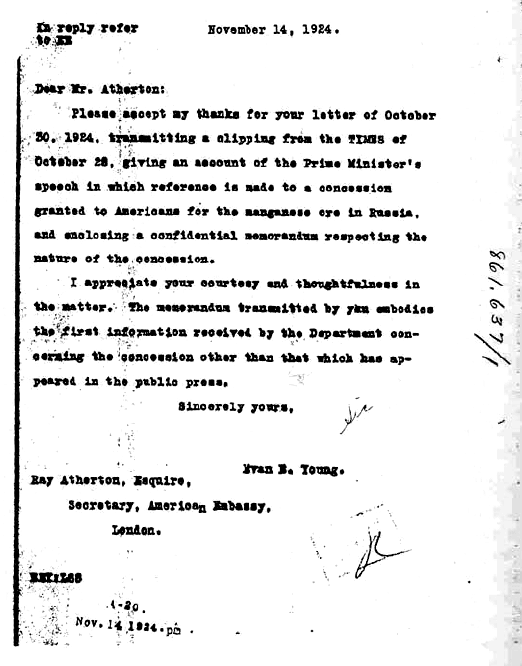
State Department Letter to U.S. Embassy In London (861.637/1)
IV.- THE ORDER TOO POWERFUL FOR STATE DEPARTMENT TO INVESTIGATE
While The Order carried out its plans to develop Russia, the State
Department could do nothing. Its bureaucrats sat in Washington D.C.
like a bunch of mesmerized jackrabbits.
Firstly, in the 1920s loans to the Soviet Union were strictly
against U.S. law. While American citizens could enter Russia at
their own risk, there were no diplomatic relations and no government
support or sanction for commercial activity. Public and government
sentiment in the United States was overwhelmingly against the
Soviets - not least for the widespread atrocities committed in the
name of the Revolution.
Secondly, the Harriman-Guaranty syndicate, which reflected The
Order, did not inform the State Department of its plans. As the
attached letter (page 152) from Washington to the London Embassy
describes, the first information of the Harriman manganese deposit
came from the American Embassy in London, which picked it up from
London newspaper reports.
In other words, Averell Harriman sneaked an illegal project past the
U.S. Government. If this is not irresponsible behavior, then nothing
is. And this was the man who was later to become the U.S. Ambassador
to Russia.
The State Department letter to London is quite specific on this
point:
"The memorandum transmitted by you embodies the first
information received by the Department concerning the concession
other than that which has appeared in the public press."
A month or so later came a letter from Department of Commerce asking
for confirmation and more information. Apparently, Harriman didn't
bother to inform Commerce either.
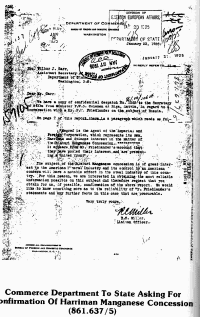 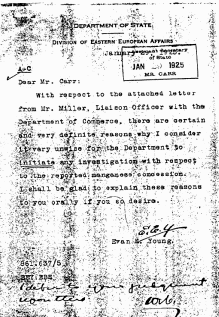
Now we reach the truly extraordinary point. The U.S. Government was
not informed by W.A. Harriman or Guaranty Trust that they intended
to invest $4 million developing Soviet manganese deposits. Yet this
was clearly illegal and a move with obvious strategic consequences
for the U.S.
Neither was the U.S. Government able to pick up this
information elsewhere; in those days there was no CIA. Economic
intelligence was handled by the State Department. It is also obvious
that Government officials were interested in acquiring information,
as they should have been.
The truly extraordinary point is THAT THE U.S. GOVERNMENT WAS NOT
ABLE TO PURSUE AN INVESTIGATION.
We reproduce on page 155 a memorandum from
Evan E. Young in Division
of Eastern European Affairs to Assistant Secretary of State Carr.
Note this is a memorandum at the upper levels of the State
Department. Young specifically writes:
"... there are certain and
very definite reasons why I consider it very unwise for the
Department to initiate any investigation with respect to the
reported manganese concession."
And Assistant Secretary of State Carr scribbles on the bottom, "I
defer to your judgment upon this" (presumably after the suggested
oral communication).
The distinct impression is that some behind-the-scenes power was not
to be challenged.
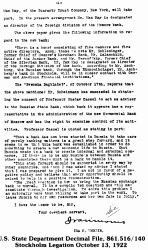 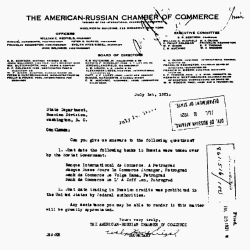
V.- THE ORDER MAKES ITS OWN LAW
The Order kept a hold on every non-government strategic position
related to the Soviet Union. Nothing appears to have escaped their
attention. For example, the Anglo-Russian Chamber of Commerce was
created in 1920 to promote trade with Russia - desperately needed by
the Soviets to restore idle Tsarist industry.
The Chairman of its
Executive Committee, the key post in the Chamber, was held by Samuel
R. Bertron (The Order '85), a Vice President of Guaranty Trust and
formerly a member of the 1917 Root Mission to Russia. Elihu Root,
Chairman of the Mission, was, of course, the personal attorney to
William Collins Whitney (The Order '63), one of the key members of
The Order.
The letter from Bertron's
Anglo-Russian Chamber of Commerce to State Department, printed on page 158 is noteworthy
because :: asks the question:
"What date trading in Russian credits
was prohibited in the United States by Federal authorities?"
This means that The Order was well aware in 1921 that "credits" to
the U.S.S.R. were illegal and indeed were not made legal until
President Roosevelt took office in 1933. However, illegal or not,
within 18 months of this Bertron letter, Guaranty Trust established
more than trading in Russian credits.
Guaranty Trust made a joint
banking agreement with the Soviets and installed a Guaranty Trust
Vice President, Max May, as director in charge of the foreign
division of this Soviet-Dank, the RUSKOMBANK (See document on page
157).
In brief, while the U.S. public was being assured by the U.S.
Government that the Soviets were dastardly murderers, while "Reds"
were being deported back to Russia by the Department of Justice,
while every politician (almost without exception) was assuring the
American public that the United States would have no relations with
the Soviets - while this barrage of lies was aimed at a gullible
public, behind the scenes the Guaranty Trust Company was actually
running a division of a Soviet bank! And American troops were being
cheered by Soviet revolutionaries for helping protect the
Revolution.
That, dear readers, is why governments need censorship. That's why
even 50 years after some events, it is almost impossible for
independent researchers (not the bootlickers) to get key documents
declassified.
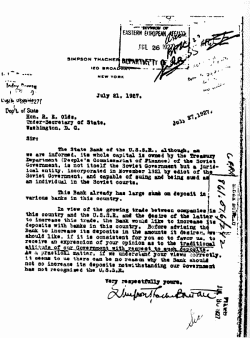
VI.- THE ORDER'S LAW FIRMS
New York establishment law firms, several founded by members of The
Order, have close links to banksand specifically those operational
vehicles for revolution already cited.
Take the example of Simpson, Thacher & Bartlett which in the 1920s
was located at 120 Broadway, New York. The firm was founded by
Thomas Thacher (The Order '71) in 1884. His son Thomas Day Thacher
(The Order '04) worked for the family law firm after leaving Yale
and initiation into The Order.
The younger Thomas Thacher went to
work for Henry L. Stimson (The Order'88), a very active member of
The Order discussed in Volume One of this series. About this time Thacher, who wrote The Order's statement on the Bolshevik Revolution
(page 138), became friendly with both Felix Frankfurter and Raymond
Robins. According to extensive documentation in the Lusk Committee
files, both Frankfurter and Robins were of considerable assistance
to the Soviets.
Another link between the 1917 Revolution and Simpson, Thacher &
Bartlett is through the daughter of Thomas Anthony Thacher (The
Order '35) who married William Kent (The Order '87) who we have
linked to member Amos Pinchot in the case of intervention on behalf
of the Soviets in Washington, D.C.
Furthermore, readers of Wall Street And The Bolshevik Revolution
will recall that member Samuel Bertron was on the Root Mission to
Russia in 1917. Moreover, Thomas Thacher (The Order '04) was a
member of the Red Cross Mission with Allan Wardwell, son of Thomas
Wardwell, Standard Oil Treasurer and a partner in another Wall
Street aw firm, Statson, Jennings & Russell (the links of this firm
to The Order will be described in a later volume). Eugene Stetson,
Jr., for example, is "The Order ('34)" .
Simpson, Thacher & Bartlett represented the Soviet State Bank in ::e
U.S. and was the vehicle used by The Order to inform State
Department of activities that might otherwise be blocked by low
level bureaucrats following the government rulebook.
For example, in 1927 Simpson, Thacher & Bartlett informed the U.S.
Government that the Soviets were in the process of substantially
increasing deposits in the U.S. This increase was in preparation for
the enormous outlays to be channeled to a few favored U.S. firms to
build the Soviet First Five Year Plan.
The letter read closely is definite; it puts words in the mouth of
the State Department, i.e., this is what we are going to do and in
spite of the U.S. Government, there is no reason why we should not
go ahead.
Note, for example, the last paragraph:
"... it seems to
us there is no reason why the Bank should not so increase its
deposits notwithstanding our Government has not recognized the U.S.S.R."
RUSSIA
During the past four years the Government of the United States has
maintained the position that it would be both futile and unwise to
enter into relations with the Soviet Government so long as the
Bolshevik leaders persist in aims and practices in the field of
international relations which preclude the possibility of
establishing relations on the basis of accepted principles governing
intercourse between nations.
It is the conviction of the Government
of the United States that relations on a basis usual between
friendly nations can not be established with a governmental entity
which is the agency of a group who hold it as their mission to bring
about the overthrow of the existing political, economic and social
order throughout the world and who regulate their conduct towards
other nations accordingly.
The experiences of various European Governments which have
recognized and entered into relations with the Soviet regime have
demonstrated conclusively the wisdom of the policy to which the
Government of the United States has consistently adhered.
Recognition of the Soviet regime has not brought about any cessation
of interference by the Bolshevik leaders in the internal affairs of
any recognizing country, nor has it led to the acceptance by them of
other fundamental obligations of international intercourse.
Certain
European states have endeavored, by entering into discussions with
representatives of the Soviet regime, to reach a settlement of
outstanding differences on the basis of accepted international
practices. Such conferences and discussions have been entirely
fruitless. No state has been able to obtain the payment of debts
contracted by Russia under preceding governments or the
indemnification of its citizens for confiscated property.
Indeed,
there is every reason to believe that the granting of recognition
and the holding of discussions have served only to encourage the
present rulers of Russia in their policy of repudiation and
confiscation, as well as in their hope that it is possible to
establish a working basis, accepted by other nations, whereby they
can continue their war on the existing political and social order in
other countries.
Current developments demonstrate the continued persistence at Moscow
of a dominating world revolutionary purpose and the practical
manifestation of this purpose in such ways as render impossible the
establishment of normal relations with the Soviet government.
The
present rulers of Russia, while seeking to direct the evolution of
Russia along political, economic and social lines in such manner as
to make it an effective "base of the world revolution", continue to
carry on, through the Communist International and other
organizations with headquarters at Moscow, within the borders of
other nations, including the United States, extensive and carefully
planned operations for the purpose of ultimately bringing about the
overthrow of the existing order n such nations.
A mass of data with respect to the activities carried on in the
United States by various Bolshevik organizations, under the
direction and control of Moscow, was presented by the Department of
State to a subcommittee of the Senate Committee on Foreign Relations
in January 1924.
VII.- WHAT THE POLITICIANS TOLD AMERICAN CITIZENS
All this Soviet-building activity recorded in the Lusk Committee and
State Department files was carefully concealed from the American
public. What the public was told can only be described as a pack of
lies, from beginning to end.
To demonstrate the degree of falsehood,
we reprint here a page on Russian from a document,
"Excerpt from a
statement entitled 'Foreign Relations' by the Honorable Frank B.
Kellogg, Secretary of State, published by the Republican National
Committee, Bulletin No. 5, I928."
Among the falsehoods promoted by
Secretary Kellogg is the following:
"... the Government of the
United States has maintained the position that it would be both
futile and unwise to enter into relations with the Soviet
Government."
In fact, at this very time the
United States, with implicit government approval, was involved
in planning the First Five Year Plan in Russia. The planning
work was done actively by American firms.1
1 This story has been described in my Western Technology And Soviet
Economic Development 1917-1930 and 1930-1945, published by the Hoover
Institution at Stanford University.
Construction of the Soviet dialectic arm continued throughout the
1930s up to World War II. In 1941
W.A. Harriman was appointed Lend Lease Administrator to assure the
flow of United States technology and products to the Soviet Union.
Examination of - Lend - ease records shows that U.S. law was violated.
The law required military goods only to be shipped. In fact,
industrial equipment in extraordinary amounts was also shipped and
Treasury Department currency plates so that the Soviets could freely
print U.S. dollars.
Since World War II the United States has kept the Soviets abreast of
modern technology. This story has been detailed elsewhere. In brief,
the creation of the Soviet Union stems from The Order. The early
survival of the Soviet Union stems from The Order. The development
of the Soviet Union stems from The Order. But above all, this story
has been concealed from the American public --,"politicians ...
more of this later. Now let's turn to the financing of the Nazi
Party in Germany.
Return to Contents
Memorandum Number Four:
Antithesis - Financing The Nazis
The Marxist version of the Hegelian dialectic poses financial
capitalism as thesis and Marxist revolution as antithesis. An
obvious puzzle in this Marxian statement is the nature of the
synthesis presumed to evolve out of the clash of these opposites,
i.e., the clash of financial capitalism and revolutionary Marxism.
Lenin's statement that the State will wither away at the synthesis
stage is nonsensical. In fact, as all contemporary Marxist states
testify, the State in practice becomes all powerful. The immediate
task of "the revolution" is to convey all power to the state, and
modern Marxist states operate under a constant paranoia that power
may indeed pass away from the hands of the State into the hands of
the people.
We suggest that world forces may be seen differently, although still
in terms of the Hegelian dialectic. If Marxism is posed as the
thesis and national socialism as antithesis, then the most likely
synthesis becomes a Hegelian New World Order, a synthesis evolving
out of the clash of Marxism and national socialism. Moreover, in
this statement those who finance and manage the clash of opposites
can remain in control of the synthesis.
If we can show that
The Order has artificially encouraged and
developed both revolutionary Marxism and national socialism while
retaining some control over the nature and degree of the conflict,
then it follows The Order will be able to determine the evolution
and nature of
the New World Order.
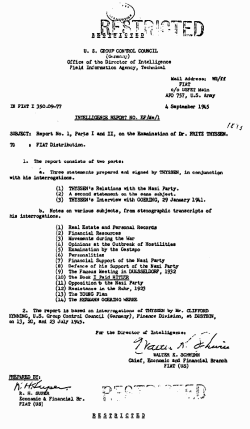
I. WHERE DID THE NAZIS GET THEIR FUNDS FOR REVOLUTION?
In
Wall Street And The Rise of Hitler we described several financial
conduits between Wall Street and the Nazi Party. This was later
supplemented by publication of a long suppressed book, Hitler's
Secret Backers.1
1 Wall Street And The Rise Of Hitler and Hitler's Secret Backers are
obtainable from Research Publications, P.O. Box 39850, Phoenix
Arizona 85069. Some other aspects are covered in Charles Higham.
Trading With The Enemy (Delacorte Press).
Still other books have emphasized the
Fritz Thyssen financial connection to Hitler. After he split with Hitler,
Thyssen himself wrote a book, I Paid Hitler. We are now in a
position to merge the evidence in these books with other material
and our documentation on The Order.
The records of the U.S. Control Council for Germany contain the
post-war intelligence interviews with prominent Nazis. From these we
have verification that the major conduit for funds to Hitler was
Fritz Thyssen and his Bank fur Handel and Schiff, previously called
von Heydt's Bank. This information coincides with evidence in Wall
Street And The Rise Of Hitler and Hitler's Secret Backers, even to
the names of the people and banks involved, i.e., Thyssen, Harriman,
Guaranty Trust, von Heydt, Carter, and so on.
The document reproduced on page 167
below, slipped through U.S. censorship
because the Office of Director of Intelligence did not know of the
link between Fritz Thyssen and the Harriman interests in New York.
Documents linking Wall Street to Hitler have for the most part been
removed from U.S. Control Council records. In any event, we
reproduce here the Intelligence report identifying Fritz Thyssen and
his Bank fur Handel und Schiff (No. EF/Me/1 of September 4, 1945)
and page 13 of the interrogation of Fritz Thyssen entitled
"Financial Support of the Nazi Party."

II. WHO WAS THYSSEN"?
Fritz Thyssen was the German steel magnate who associated himself
with the Nazi movement in the early '20s. When interrogated in 1945
under Project Dustbin, Thyssen recalled that he was approached in
1923 by General Ludendorf at the time of French evacuation of the
Ruhr. Shortly after this meeting Thyssen was introduced to Hitler
and provided funds for the Nazis through General Ludendorf.
In 1930-31 Emil Kirdorf approached Thyssen and subsequently sent
Rudolf Hess to negotiate further funding for the Nazi Party. This
time Thyssen arranged a credit of 250,000 marks at the Bank Voor
Handel en Scheepvaart N.V. (the Dutch name for the bank named by
Thyssen in the attached document), at 18 Zuidblaak in Rotterdam,
Holland.
Thyssen was former head of the Vereinigte Stahlwerke,
the
German steel trust, financed by Dillon Read (New York), and played a
decisive role in the rise of Hitler to bower by contributing
liberally to the Nazi Party and by influencing his fellow
industrialists to join him in support of the Fuehrer. In reward for
his efforts, Thyssen was showered with political and economic favors
by the Third Reich and enjoyed almost unlimited power and prestige
under the Nazi regime until his break with Hitler in 1939 over the
decision to invade Poland and precipitate the Second World War.
This incident and Thyssen's subsequent publication, I Paid Hitler,
has a parallel with the history of his father, August Thyssen.
Through a similar confession in 1918 the elder Thyssen, despite his
record as a staunch backer of pan-Germanism, succeeded in convincing
the Allies that sole responsibility for German aggression should be
placed on the Kaiser and German industrialists should not be blamed
for the support they had given to the Hohenzollerns.
Apparently
influenced by August Thyssen and his associates, the Allies made no
effort to reform German industry after World War I. The result was
that Thyssen was allowed to retain a vast industrial empire and pass
it on intact to his heirs and successors.
It was against this background that Fritz Thyssen took over control
of the family holdings following the death of his father in 1926.
The new German steel baron had already achieved fame throughout the
Reich by his defiance of the French during their occupation of the
Ruhr in 1923. Like Hitler, Thyssen regarded the Treaty of Versailles
as "a pact of shame" which must be overthrown if the Fatherland were
to rise again This is the story in Hitler's Secret Backers.
Thyssen set out along the same road as his father, aided by ample
Wall Street loans to build German industry. August Thyssen had
combined with Hugenburg, Kirdorf, and the elder Krupp to promote the
All-Deutscher Verband (the Pan-German League), which supplied the
rationale for the Kaiser's expansionist policies.
His son became an active member of the Stahlhelm and later, through
Goring, joined the Nazis. Finally, after the crash of 1931 had
brought German industry to the verge of bankruptcy, he openly
embraced national socialism.
During the next 2 years Thyssen dedicated his fortune and his
influence to bring Hitler to power. In 1932 he arranged the famous
meeting in the Dusseldorf Industrialists' Club, at which Hitler
addressed the leading businessmen of the Ruhr and the Rhineland. At
the close of Hitler's speech Thyssen cried, "Heil Herr Hitler,"
while the others applauded enthusiastically.
By the time of the
German Presidential elections later that year, Thyssen obtained
contributions to Hitler's campaign fund from the industrial
combines. He alone is reported to have spent 3,000,000 marks on the
Nazis in the year 1932.
III. THE UNION BANKING CONNECTION
This flow of funds went through Thyssen banks. The Bank fur Handel
and Schiff cited as the conduit in the U.S. Intelligence report was a subsidiary of the August Thyssen
Bank, and founded in 1918 with H.J. Kouwenhoven and D.C. Schutte
as managing partners. In brief, it was Thyssen's personal banking
operation, and affiliated with the W.A. Harriman financial interests
in New York.
Thyssen reported to his Project Dustbin interrogators
that:
"I chose a Dutch bank because I did not want to be mixed up with
German banks in my position, and because I thought it was better to
do business with a Dutch bank, and I thought I would have the Nazis
a little more in my hands."
Hitler's Secret Backers identifies the conduit from the U.S. as "von Heydt," and von Heydt's Bank was the early name for Thyssen's Bank.
Furthermore, the Thyssen front bank in Holland - i.e., the Bank voor
-iandel en Scheepvaart N.V. - controlled the Union Banking
Corporation in New York.
The Harrimans had a financial interest in, and
E. Roland Harriman
(The Order 1917), Averell's brother, was a director of this Union
Banking Corporation. The Union Banking Corporation of New York City
was a joint Thyssen-Harriman operation with the following directors
in 1932:
-
E. Roland Harriman (The Order
1917) Vice President of W.A. Harriman & Co., New York
-
H.J. Kouwenhoven (Nazi) Nazi banker, managing partner of August Thyssen
Bank and Bankvoor Handel Scheepvaart N.V. (the transfer bank for Thyssen's
funds)
-
Knight Wooley (The Order 1917) Director of Guaranty Trust, New York and Director
Federal Reserve Bank of N. Y.
-
Cornelius Lievense President, Union Banking Corp. and Director of
Holland-American Investment Corp.
-
Ellery Sedgewick James (The
Order 1917) Partner, Brown Brothers, & Co., New York
-
Johann Groninger (Nazi) Director of Bank voor Handel en Scheepvaart and
Vereinigte Stahlwerke (Thyssen's steel operations)
-
J.L. Guinter Director Union Banking Corp
-
Prescott Sheldon Bush (The Order
1917) Partner, Brown Brothers, Harriman. Father of
President G. H. W. Bush
The eight directors of Union Banking Corporation are an interesting
bunch indeed.
Look at the following:
-
Four directors of Union Banking are members of The Order: all
initiated at Yale in 1917 - members of the same Yale class. All four
were members of the same cell (club) D 115.
-
E. Harriman was the brother of W. Averell Harriman and a
Vice-President of W.A. Harriman Company.
-
Guaranty Trust was represented by Knight Woolley.
-
Two of the Union directors, Kouwenhoven and Groninger, were Nazi
directors of Bank voor Handel en Scheepvaart, formerly the von Heydt
Bank.
-
Von Heydt was the intermediary between Guaranty Trust and
Hitler named in Hitler's Secret Backer.
-
Ellery S. James and Prescott S. Bush were partners in Brown
Brothers, later Brown Brothers, Harriman.
Out of eight directors of Thyssen's bank in New York, we can
therefore identify six who are either Nazis or members of The Order.
This private bank was formerly named Von Heydt Bank and von Heydt is
named by Shoup in
Hitler's Secret Backers as the intermediary from
Guaranty Trust in New York to Hitler between 1930 and 1933. Above
all, remember that Shoup was writing in 1933 when this information
was still only known to those on the inside. Out of tens of
thousands of banks and bankers, Sharp, in 1933, names those that
evidence surfacing decades later confirms as financing Hitler.
In brief, when we merge the information in PROJECT DUSTBIN with
Shoup's Hitler's Secret Backers, we find the major overseas conduit
for Nazi financing traces back to THE ORDER and specifically cell D
115.
IV. PROFIT FROM CONFLICT
Out of war and revolution come opportunities for profit.
Conflict can be used for profit by corporations under control and
influence of The Order. In World War II, the Korean War and the
Vietnamese War we can cite examples of American corporations that
traded with "the enemy" for profit.
This "blood trade" is by no means sporadic or limited to a few
firms; it is general and reflects higher policy decisions and
philosophies. Corporations - even large corporations -are dominated
by banks and trust companies, and in turn these banks and trust
companies are dominated by The Order and its allies. (This will be
the topic of a forthcoming volume).
Although the U.S. did not officially go to war with Germany until
1941, legally, and certainly morally, the U.S. was at war with Nazi Germany after the Destroyer deal with
Great Britain in December 1940, :.e., the exchange of 50 old U.S.
destroyers for strategic bases in British territory.
Even before
December 1940 the MS "Frederick S. Fales" owned by Standard Vacuum
Company was sunk by a German submarine on September 21, 1940. Yet in
1941 Standard Oil of New Jersey (now EXXON) had six Standard Oil
tankers under Panamanian registry, manned by Nazi officers to carry
fuel oil from Standard Oil refineries to the Canary Islands, a
refueling base of Nazi submarines.
A report on this dated July 15, 1941 from Intelligence at Fifth
Corps :n Columbus, Ohio is reproduced on page 172. The report is in
error recording that no Standard Oil ships had been sunk by the
Nazis; Major Burrows apparently did not know "Frederick S. Fales" in
1940.
Another example of profit from war is recorded in the document on
page 173. This records the association of RCA and the Nazis in World
War II. RCA was essentially a Morgan-Rockefeller firm and so linked
to The Order.
Yet another example is that of Chase Bank.
Chase was linked to The
Order through the
Rockefeller family (Percy Rockefeller, The Order
1900) and Vice-President Reeve Schley (Yale, Scroll & Key).
Directors of Chase in The Order included Frederick Allen (The Order
1900), W.E.S. Griswold (The Order 1899) and Cornelius Vanderbilt,
whose brother Gwynne Vanderbilt (The Order 1899) represented the
family before his death. President of Chase was Winthrop Aldrich.
This was :he Harvard branch of the Aldrich family, another branch is
Yale and The Order.
Chase Manhattan Bank is not only a firm that plays both sides of the
political fence, but with Ford Motor Company, was selected by
Treasury Secretary Morgenthau for post-war investigation of pro-Nazi
activities: These two situations [i.e., Ford and Chase Bank]
convince us that it is imperative to investigate immediately on the
spot the activities of subsidiaries of at least some of the larger
American firms which were operating in France during German
occupation ...
The extent of Chase collaboration with Nazis is staggering - and
this was at a time when Nelson Rockefeller had an intelligence job
in Washington aimed AGAINST Nazi operations in Latin America.
In December 1944 Treasury Department officials examined the records
of the Chase Bank in Paris. On December 20, 1944 the senior U.S.
examiner sent a memorandum to Treasury Secretary Morgenthau with the
preliminary results of the Paris examination.
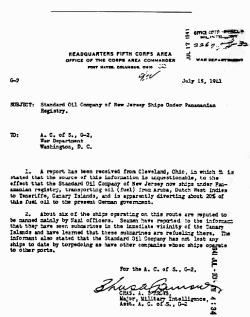 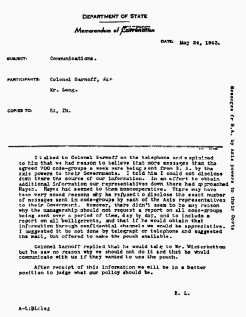
Here's an extract from
that report:
-
Niederman, of Swiss nationality, manager of Chase, Paris, was
unquestionably a collaborator;
-
The Chase Head Office in New York was informed of Niederman's
collaborationist policy but took no steps to remove him. Indeed
there is ample evidence to show that the Head Office in New York
viewed Niederman's good relations with the Germans as an excellent
means of preserving, unimpaired, the position of the Chase Bank in
France.
-
The German authorities were anxious to keep the Chase open and
indeed took exceptional measures to provide sources of revenue.
-
The German authorities desired "to be friends" with the important
American banks because they expected that these banks would be
useful after the war as an instrument of German policy in the United
States.
-
The Chase, Paris showed itself most anxious to please the , German
authorities in every possible way. For example, the Chase zealously
maintained the account of the German Embassy in Paris, "as every
little thing helps" (to maintain the excellent relations between
Chase and the German authorities).
-
The whole objective of the Chase policy and operation was to
maintain the position of the bank at any cost. In brief, Chase Bank
was a Nazi collaborator, but the above preliminary report is as far
as the investigation proceeded. The report was killed on orders from
Washington, D.C.
On the other hand, Chase Bank, later
Chase
Manhattan Bank, has been a prime promoter of exporting U.S.
technology to the Soviet Union. This goes all the way back to the
early 1920s when Chase broke U.S. regulations in order to aid the Soviets. As early as 1922 Chase was
trying to export military LIBERTY aircraft engines to the Soviet
Union!
In conclusion, we have seen that the two arms of the dialectic
described in Memoranda Three and Four clashed in World War II.
Furthermore, the corporate segment of the elite profited from Lend
Lease to the Soviets and by underground cooperation with Nazi
interests. The political wing of The Order was at the same time
preparing a new dialectic for the post World War II era.
Return to Contents
Memorandum Number Five:
The New Dialectic - Angola And China
I. THE NECESSITY FOR A NEW DIALECTIC PROCESS
World War II was the culmination of the dialectic process created in
the 1920s and 1930s. The clash between "left" and "right," i.e., the
Soviet Union and Nazi Germany, led to creation of a synthesis -
notably the United Nations, and a start towards regional groupings
in -:,e Common Market, COMECON, NATO, UNESCO, Warsaw Pact, SEATO,
CENTO, and then the Trilateral Commission. A start towards New World
Order.
World War II left The Order with the necessity to create a new
dialectical situation to promote more conflict to achieve a higher
level synthesis.
The source of the current process may be found in National Security
Memorandum No. 68 of 1950, with its extraordinary omissions
(analyzed in The Phoenix Letter, January 1984). NSC 68 opened up the
road for Western technology to build a more advanced Soviet Union -
which it did in the 1960s and 1970s with computerized space-age
technology. At the same time NSC 68 presented the argument for
massive expansion of
U.S. defenses - on the grounds of a future Soviet threat. The
omission in NSC 68 was quite elementary, i.e., that :he Soviets
could not progress without Western technology. NSC 68 allowed that
technology transfer to go on. In other words, by allowing Western
firms to expand the Soviet Union, NSC-68 also pari passu created the
argument for a U.S. defense budget. We identified in our 'Phoenix
Letter article the link between NSC-68 and The Order.
Unfortunately for
The Order, but not surprisingly, given their
limited perception of the world, the dialectic plan based on NSC-68
misfired. The principal devices used to control the dialectic
process in the past two decades have been:
(a) information
(b) debt
(c) technology
These have become diluted over time.
They just
don't work as well today as they did in the 1950s. By and large,
control of information has been successful. The intellectual world
is still locked into a phony verbal battle between "left" and
"right," whereas the real struggle is the battle between individual
freedom and the encroaching power of the absolute State.
The Soviet
Union, with its tight censorship, presents a strictly Marxist (i.e.,
"left") orientation to its citizens. The enemy is always the
"fascist" United States. The West is a little more complicated but
not much more so. Quigley's argument in Tragedy And Hope, that
J.P.
Morgan used financial power to control politics, has been extended
to The Order's control of information. In the West the choice is
basically between a controlled "left-oriented" information and a
controlled "right-oriented" information.1
1 There are exceptions. Obviously Review Of The News, American
Opinion and Reason are large outside the controlled right' frame. To
some extent the U.S. Labor Party is outside the left frame but
includes so much spurious material that its publications are hardly
worth reading. Henry George sit clear-cut left exception.
The conflict between the
two controlled groups keeps an apparent informational conflict
alive. Unwelcome facts that fall into neither camp are conveniently
forgotten. Books that fall into neither camp can be effectively
neutralized because they will incur the wrath of both "right" and
"left".
In brief, any publication which points up the fallacy of the
Left-Right dichotomy is ignored ... and citizens keep trooping down
to the polling booths in the belief they have a "choice".
The second control mechanism is debt. If Marxist countries have to
import technology, they need to earn or borrow Western currencies to
pay for it. Loans have to be repaid. So to some extent, debtors are
under control of creditors, unless they default. Default is the
weakness
The third control mechanism is technology. If technology to advance
to more efficient production levels has to be imported, then the
recipient is always kept away from the "state of the art". The
weakness for The Order is that military technology does not require
a market system.
The dialectic plan therefore misfired for several reasons. Firstly,
the informational blackout has not been as successful as The Order
expected. We shall describe later how control of Time and Newsweek
gave The Order dominance over weekly news summaries. The TV networks
have been able to orchestrate viewer reactions - to some extent. For
example, the three ABC blockbusters in 1983 were The Day After,
Thornbirds, and Winds Of War, all with a common propaganda theme.
But
The Order was unable to restrict individuals and relatively small
non-academic groups, almost always outside Universities, from
exploring obvious inconsistencies in establishment propaganda. These
groups often mistakenly termed "left" or "right" are outside the
generally manipulated left-right spectrum.
Secondly, the debt weapon was over-used. Communist countries are now
saturated with debt to Western bankers. Thirdly, while technology is
still a useful weapon, there are distinct stirrings among
independent analysts of the danger posed for the Western world by
building enemies.
Consequently, in today's world we can identify two facts in
construction of a new dialectic.
-
First, cautious reinforcement of
the Marxian arm (the thesis presented in Memorandum Three), i.e.,
Marxist Angola gets a green light, but a Marxist Grenada got a red
light.
-
Second, the construction of a completely new arm, that of Communist
China, itself Marxist, but with conflict potential for the Soviet
Union.
Major efforts by The Order are in progress, only partly
revealed in the press, to create a new superpower in a conflict mode
with the Soviet Union. This is the new antithesis, replacing Nazi
Germany.
II. THE ORDER CREATES A MARXIST ANGOLA
Angola, a former Portuguese province on the southwest coast of
Africa, is a contemporary example of continued, but more cautious,
creation of the Marxist arm of the dialectic process. The official
establishment view of Angola is that Angola was a Portuguese colony
and oppressive Portuguese rule led to an independence movement in
which the Marxists won out over "democratic" forces.
This view cannot be supported. If the Portuguese were colonists in
Angola, then so are the Boston Brahmins in Massachusetts. Luanda,
the chief town in Angola, was settled by the Portuguese in 1575 -
that's half a century before the Pilgrims landed in Massachusetts.
The indigenous population of Angola in 1575 was less than the Indian
population of Massachusetts. Over three centuries the Portuguese
treated Angola more as a province than as a colony, in contrast to
British, French and Belgian colonial rule in Africa. So if Angola
belonged to non-existent indigenous natives, then so does
Massachusetts logically belong to American Indians.
In the early 1960s the United States was actively aiding the Marxist
cause in Angola. This is clear from former Secretary of State Dean
Acheson. The following extracts are from a memorandum recording a
conversation between Dean Acheson (Scroll & Key), McGeorge Bundy The
Order '40), and President Kennedy dated April 2, 1962:
"He [Kennedy] then turned to the negotiations with Portugal over the
Azores base. He said that not much seemed to be happening and that
he would be grateful to have me take the matter over and see if
something could be done.
I asked him for permission to talk about
the situation for a few minutes and said about the following:
"The
Portuguese were deeply offended at what they believed was the
desertion of them by the United States, if not the actual alignment
of the United States with their enemies. The problem, it seemed to
me, lay not so much in negotiations with the Portuguese as in the
determination of United States policy. The battle would be in
Washington, rather than in Lisbon."
Then Dean Acheson comments on a topic apparently already known
to
President Kennedy, that the United States was supporting the revolutionary movements in Angola:
"The President then asked me why I was so sure that there was no
room for negotiations under the present conditions. I said that, as
he perhaps knew, we had in fact been subsidizing Portugal's enemies;
and that they strongly suspected this, although they could not prove
it. He said that the purpose of this was to try to keep the Angolan
nationalist movement out of the hands of the communist Ghanians,
etc., and keep it in the most moderate hands possible.
I said that I
quite understood this, but that it did not make what the Portuguese
suspected any more palatable to them. We were also engaged in
smuggling Angolese out of Angola and educating them in Lincoln
College outside of Philadelphia in the most extreme nationalist
views. Furthermore the head of this college had secretly and
illegally entered Angola and on his return had engaged in violent
anti-Portuguese propaganda.
We voted in the United Nations for
resolutions "condemning" Portugal for maintaining order in territory
unquestionably under Portuguese sovereignty. I pointed out that the
Portuguese were a proud people, especially sensitive because they
had declined to such an impotent position after such a glorious
history. They would rather proceed to the ruin of their empire in a
dignified way, as they had in Goa, than be bought or wheedled into
cooperating in their own destruction."
There is an extremely important,
although seemingly minor, point in President Kennedy's comments.
Kennedy apparently believed the U.S. was financing Nationalists, not
Marxists, whereas the U.S. was actually aiding Marxists, as it was
later to do in South Africa, following a pattern going back to the
1917 Bolshevik Revolution in Russia.
There is a point well worth
following up in the Kennedy files, i.e., just how much Kennedy knew about CIA and State
Department operations, where The Order was in control.
The Marxists under Neto's MPLA obtained control of Angola. The Order
with powerful allies among multinational corporations has exerted
pressure on successive Administrations to keep Angola as a
Cuban-Soviet base in Southern Africa.
Back in 1975 the U.S. in conjunction with South Africa did indeed
make a military drive into Angola. At a crucial point, when South
African forces could have reached Luanda, the United States called
off assistance. South Africa had no choice but to retreat. South
Africa learned the hard way that the U.S. is only nominally
anti-Marxist. In practice the U.S. did to South Africa what it had
done many times before - the elite betrayed its anti-Marxist allies.
By the early 1980s The Order's multinational friends came out of the
woodwork while carefully coordinating public actions with Vice
President Bush (The Order 1948). For example, in March 27, 1981 The
Wall Street Journal ran a revealing article, including some nuggets
of reality mingled with the Establishment line.
This front page
article viewed U.S. multinational support for the Angolan Marxists
under the headline,
"Friendly Foe: companies urge U.S. to stay out of
Angola, decline aid to rebels" (these rebels being anti-Marxist Savimbi's UNITA forces aided by South Africa).
The leader of the pro-Marxist corporate forces in the U.S. is Melvin
J. Hill, President of Gulf Oil Exploration & Production Company, a
unit of Gulf Oil which operates Gulf Cabinda. This is a refinery
complex in Angola, protected from Savimbi's pro-Western rebels by
Cubans and Angolan Marxist troops.
Hill told the WSJ "Angola is a
knowledgeable, understanding and reliable business partner." Hill
not only appeared before Congress with this pro-Marxist line, but
met at least several times with then Vice President Bush.
PWJ Wood of Cities Service added more to the Gulf Oil mythology.
Said Wood:
"The Angolans are more and more development oriented.
They aren't interested in politicizing central Africa on behalf of
Cubans or the' Soviet Union. Our people aren't persona non grata in
Angola."
Hill and Wood, of course, are no more than public relations agents
for Marxist Angola, although we understand they have not registered
as foreign agents with the U.S. Department of Justice. Angola is
very much a Cuban-Soviet base for the take-over of Southern Africa,
yet 17 western oil companies and other firms are in Angola.
They
include Gulf, Texaco, Petrofina, Mobil, Cities Service, Marathon Oil
and Union Texas Petroleum. Other firms include Allied Chemical,
Boeing Aircraft, General Electric - and Bechtel Corporation. It
should be remembered that both Secretary of State Schultz and
Secretary of Defense Weinberger are on loan from Bechtel
Corporation.
Gulf Oil Corporation is controlled by the Mellon interests. The
largest single shareholder of the outstanding shares. The Mellon
Bank is represented on the Board of Gulf Oil by James Higgins, a
Yale graduate but not, so far as we can determine, a member of The
Order.
The next largest shareholder is the Mellon Family comprising the
Andrew W. Mellon Foundation, the Richard King Foundation, and the
Sarah Scaife Foundation. This group, which thinks of itself as "conservative," holds about 7 percent of the outstanding shares.
Morgan Guaranty Trust (a name we have encountered before) holds 1.8
million shares or about 1 percent of the outstanding shares.
To a great extent these corporations with Angolan interests have
themselves out on a limb. It is surprising, for example, that South
Africa has not moved to take counter action against Angolan based
firms, especially General Electric, Boeing, Morgan Guaranty Trust,
Gulf Oil and Cities Service. After all, the South Africans are
directly losing men from the massive support given to the Angolan
Marxists by these firms.
It would be cheaper in South African lives to direct retaliatory
action against the corporations rather than against Cubans and
Angolans. After U.S. betrayal of South Africa in 1975, when South
African forces could have reached Luanda, it is a tribute to South
Africa's caution that it has not used this rather obvious counter
weapon.
After all, a South African surgical strike on Cabinda would
neatly remove the Angolans' largest single source of foreign
exchange, and give multinational Marxists a little food for thought.
We are not, of course, recommending any such action, but it does
remain an option open to South Africa.
And the possible U.S.
reaction?
Well the State Department and CIA had best be ready with
an explanation for the U.S. Embassy plane caught photographing South
African military installations! We cite the above only to
demonstrate the dangerous nature of The Order's conflict management
scenarios.
III. THE ORDER BUILDS A NEW DIALECTIC ARM IN CHINA
Just as we found the Bush family involved with the early development
of the Soviet Union, then with financing the Nazis, and vaguely
behind the scenes in Angola, so we find a Bush active in
construction of the new dialectic arm: Communist China.
In 1971 Mr. Nixon appointed George "Poppy" Bush (The Order 1948) as
U.S. Ambassador to the United Nations, irrespective of the fact that
Bush had no previous experience in diplomacy. As chief U.S.
delegate, Bush had responsibility for defense against the Communist
Chinese attack on the Republic of China, an original free enterprise
member of the United Nations.
With the vast power of the United
States at his disposal, Bush failed miserably: the Republic was
expelled from United Nations and Communist China took its seat.
Shortly after that fiasco, Bush left United Nations to take over as
Chairman of the Republican National Committee.
This is not the place to tell the whole story of American
involvement in China. It began with Wall Street intervention into
the Sun Yat Sen revolution of 1911 - a story not yet publicly
recorded.
During World War II the United States helped the Chinese Communists
into power. As one Chinese authority, Chin-tung Liang, has written
about General Joseph W. Stilwell, the key U.S. representative in
China from 1942 to 1944:
"From the viewpoint of the struggle
against Communism ... [Stilwell] did a great disservice to
China."1
Yet Stilwell only reflected orders from Washington, from General
George C. Marshall. And as Admiral Cooke stated to Congress,
2... in 1946 General
Marshall used the tactics of stoppage of ammunition to invisibly
disarm the Chinese forces.
1 Chin-Tun Liang, General Stilwell In Chino, 1942-1944: The Full
Story. St. John's University 1972, p. 12.
2 Ibid., p. 278.
But when we get to General Marshall we need to remember that in the
U.S. the civilian branch has final authority in matters military and
:',at gets us to then Secretary of War Henry L. Stimson, Marshall's
superior and a member of The Order (1888). By an amazing
coincidence, Stimson was also Secretary of War in 1911 - at the time
of the Sun Yat Sen revolution.
The story of the betrayal of China and the role of The Order will
have :o await yet another volume. At this time we want only to
record the decision to build Communist China as a new arm of the
dialectic - a ,decision made under President Richard Nixon and
placed into operation by Henry Kissinger (Chase Manhattan Bank) and
George "Poppy" Bush (The Order).
As we go to press (early 1984) Bechtel Corporation has established a
new company, Bechtel China, Inc., to handle development, engineering
and construction contracts for the Chinese government. The new
resident of Bechtel China, Inc. is Sydney B. Ford, formerly
marketing manager of Bechtel Civil & Minerals, Inc. Currently
Bechtel is working on studies for the China National Coal
Development Corporation and the China National Offshore Oil
Corporation - both, of course, Chinese Communist organizations.
It appears that Bechtel is now to play a similar role to that of
Detroit based Albert Kahn, Inc., the firm that in 1928 undertook
initial studies and planning for the First Five Year Plan in the
Soviet Union. By about the year 2000 Communist China will be a
"superpower" built by American technology and skill. It is
presumably the intention of The Order to place this power in a
conflict mode with the Soviet Union.
There is no doubt Bechtel will do its job. Former CIA Director
Richard Helms works for Bechtel, so did Secretary of State George
Shultz and Defense Secretary Caspar Weinberger. That's a powerful,
influential combination, if any Washington planner concerned with
national Security gets out of line sufficiently to protest.
Yet,
The Order has probably again miscalculated. What will be
Moscow's reaction to this dialectic challenge? Even without
traditional Russian paranoia they can be excused for feeling more
than a little uneasy.
And who is to say that the Chinese Communists
will not make their peace with Moscow after 2000 and join forces to
eliminate the super-super-power - the United States?
Return to Contents
|
















